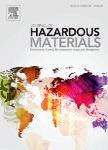版权所有:内蒙古大学图书馆 技术提供:维普资讯• 智图
内蒙古自治区呼和浩特市赛罕区大学西街235号 邮编: 010021

作者机构:Tongji Univ Coll Environm Sci & Engn State Key Lab Pollut Control & Resources Reuse Shanghai 200092 Peoples R China Shanghai Inst Pollut Control & Ecol Secur Shanghai 200092 Peoples R China
出 版 物:《JOURNAL OF HAZARDOUS MATERIALS》 (危险物资杂志)
年 卷 期:2024年第462卷
页 面:132714页
核心收录:
学科分类:0830[工学-环境科学与工程(可授工学、理学、农学学位)] 08[工学]
基 金:National Natural Science Foundation of China
主 题:Laccase Covalent organic framework Immobilization High activity and stability Oxidative polymerization process
摘 要:In current water treatment processes, pollutants are typically degraded into small molecules and CO2 for detoxification. This study employed laccase-mediated aggregation of new pollutants with natural phenolic compounds to remove pollutants by forming large molecular substances, effectively sequestering carbon. Free laccase is susceptible to environmental influences, causing deactivation. However, immobilizing laccase onto a carrier enhances enzyme stability. In the experiment, laccase was immobilized onto the covalent organic framework TpPa-1 through an in-situ loading process, resulting in immobilized laccase Lac@TpPa-1. Stability studies revealed that immobilized laccase outperformed free laccase in terms of pH, temperature, and recyclability. Moreover, immobilized laccase was employed for catalyzing the removal of emerging pollutants containing natural phenolic compounds, achieving an 80.53% removal rate with the addition of 0.02 g of laccase within 5 h. Analytical techniques like Fourier-transform ion cyclotron resonance mass spectrometry were used to uncover reaction pathways, demonstrating the presence of radical polymerization and 1, 4 nucleophilic addition. This research utilized TpPa-1 as a carrier for laccase immobilization, promoting oxidation-induced polymerization for efficient pollutant removal. It provides a theoretical foundation for understanding the interplay between emerging pollutants and phenolic compounds in natural environments and enhances the practical application of laccase through immobilization.